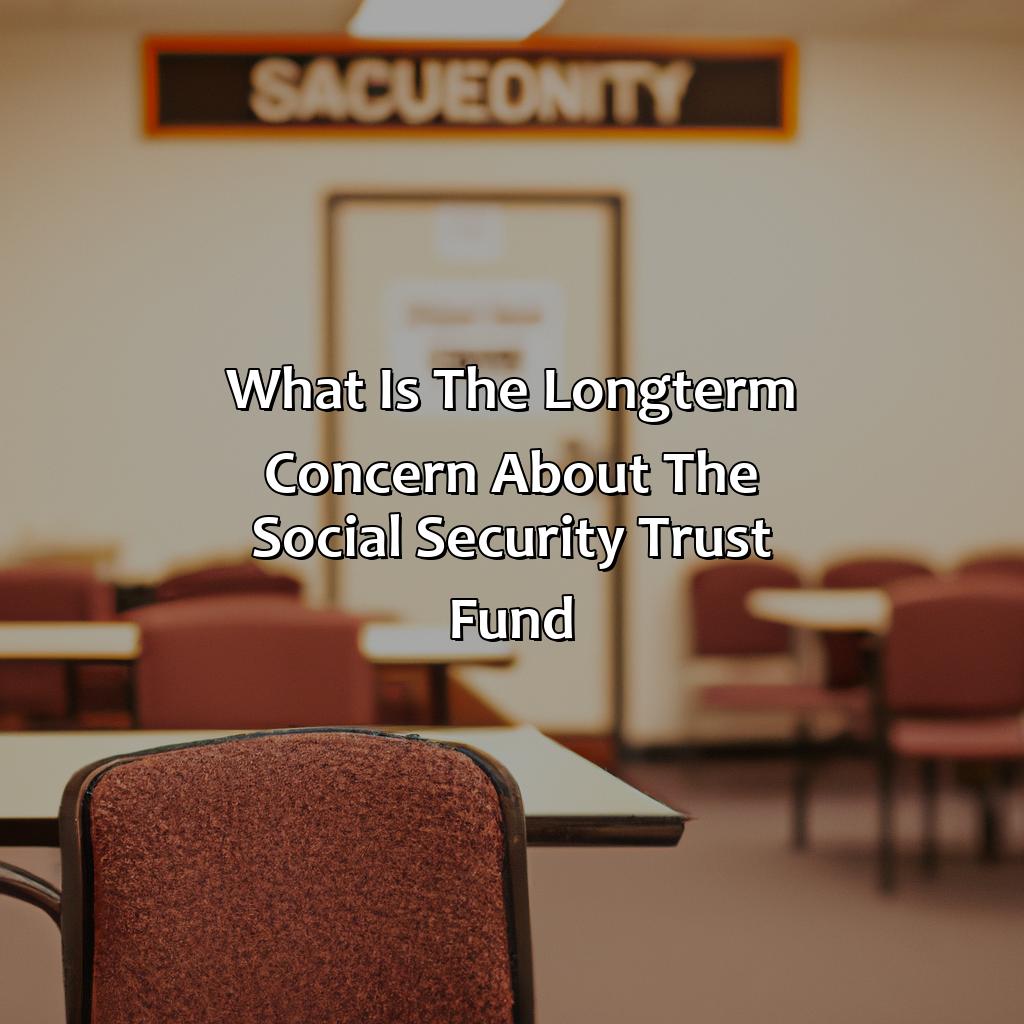What Is The Long-Term Concern About The Social Security Trust Fund?
Key Takeaway:
- Long-term concern about the social security trust fund is due to demographic changes and increased benefits: As the population ages, there are fewer workers contributing to the fund, while the number of retirees drawing benefits continues to rise. This demographic shift, combined with increased benefits, creates a funding shortfall that, if left unaddressed, could deplete the trust fund by 2035, leading to potential cuts in benefits for retirees.
- Potential solutions to the long-term concern about the social security trust fund include increasing revenue and decreasing expenses: To address the funding shortfall, policymakers could potentially consider raising the payroll tax, expanding the tax base, increasing the retirement age, means-testing benefits, or reducing cost-of-living adjustments. Alternatively, decreasing expenses could involve reducing administrative costs or finding ways to make the program more efficient.
- Addressing the long-term concern about the social security trust fund is crucial for ensuring its sustainability: Social security is a critical safety net for millions of retirees, disabled individuals, and survivors. Failure to address the long-term concern could result in reduced benefits, increased taxes, or a potential collapse of the program altogether, making it imperative for policymakers to act now.
Are you concerned about the future of social security? This article explores the long-term concern of the social security trust fund and how it impacts the American public. Withdrawals from the trust fund could have significant implications for retirees and future generations.
Background of the Social Security Trust Fund
The History of the Social Security Trust Fund can be traced back to the Social Security Act of 1935. The primary goal was to provide a safety net for retired Americans who have paid into the system. A portion of the payroll taxes from current workers goes into the trust fund to pay for benefits for those who have retired. Over the years, the trust fund has faced various challenges, including demographic shifts and economic downturns, which have put a strain on its solvency.
As the population ages and the ratio of workers to retirees declines, concerns have been raised about the trust fund’s long-term sustainability. Despite efforts to address the issue, there are no easy solutions. The government has considered options such as increasing the retirement age, raising taxes, or reducing benefits. Each of these proposals has its own set of challenges and political implications.
To ensure the long-term viability of the Social Security Trust Fund, a combination of measures is likely necessary. For instance, a combination of moderate tax increases, gradual benefit reductions for high-income earners, and a gradual increase in the retirement age could help extend the life of the trust fund. While these measures may not be popular, they are necessary to ensure that future generations can retire with financial security.

Image credits: retiregenz.com by James Arnold
Current Status of the Trust Fund
To comprehend the present state of the social security trust fund and take on any long-term issues, you must analyze its funding sources and expenses. In this segment, we’ll talk about the trust fund’s funding sources and expenditures, broken down into two subsections – Funding Sources and Expenditures.
Image credits: retiregenz.com by David Duncun
Sub-Heading: Funding Sources
Social Security Trust Fund receives its funding from various sources. Here are six major sources of funds:
- Payroll taxes – Contributions made by employees, employers and self-employed individuals to the Social Security fund.
- Interest income – The interest which is earned from the government bonds that are held by the Trust Fund.
- Taxation of benefits – A portion of beneficiaries’ Social Security benefits may be subject to taxation to fund the trust fund.
- General revenue transfers: If money received from payroll taxes and interest income is not enough, additional aid can be given to the fund via general revenue transfers.
- Treasury Securities & Bonds Sales – The sale of Treasury bonds or securities also contributes a significant amount to the social security trust fund.
- Credit Interest Earnings – In some cases, adjustments can be made to credit excess earnings that were over-taxed in prior years back to workers’ individual SS accounts. This credit contribution can aid in funding as well.
It’s important to note that contributions vary across taxpayers and that any change (in demographics) could have a massive impact on perceived shortfall. Due such raising awareness about how much and where money comes from for funding Social Security remains an important part of presidential campaigns.
There was recently a widely shared news article about a young doctor who unexpectedly became disabled for several months due to an unforeseen medical condition. During her period out of work she began worrying over lack of savings safety nets especially since she wasn’t able work overtime under disability leave and this led her questioning future support she will receive if needed through Social security if it goes bust.
Looks like the social security trust fund is experiencing some serious spending issues, let’s hope they don’t blow the budget on avocado toast.
Sub-Heading: Expenditures
Expenditures have a crucial role in the maintenance of the Social Security Trust Fund. Here are three points to consider:
- Current expenditures, especially for beneficiaries, are higher than incoming revenue from taxes and interest on investments.
- Reserves will be gradually utilized to pay for benefits over time, ultimately leading to depletion in 2035.
- The Trustees’ recent projection suggests that without changes to the current legislation, after 2035, Social Security could only support about 75% of scheduled benefits.
Additionally, the low growth rate of the economy may increase difficulty in replenishing the fund. Hence, significant and transformative measures would need incorporation into the plan before it is too late.
Possible measures include increasing payroll taxes like FICA by one percentage point or extending taxable income or perhaps reducing benefits. Additionally, efforts to create sustainable economic growth can increase revenue collection whilst developing innovative ways to manage accumulated debt with lower interest rates. These suggestions work best when combined as a combination strategy.
I guess we’ll have to rely on the trust fund’s social skills to charm its way into financial stability.
Long-Term Concerns
To grasp issues related to the social security trust fund, explore its demographic changes and benefits. Also, look at the funding shortfall sub-sections. Demographic shifts are affecting the program’s future. Budgetary constraints make it difficult to fund it.

Image credits: retiregenz.com by James Arnold
Sub-Heading: Demographic Changes and Benefits
The long-term concern regarding social security trust fund stems from changes in demographics and benefits. As the Baby Boomer generation retires, the number of beneficiaries will increase, while the number of workers contributing to the fund decreases. This could lead to a shortfall in funding for future generations. Additionally, with increasing life expectancies, beneficiaries may require benefits for longer periods.
To mitigate this concern, policymakers have explored options such as raising retirement ages or adjusting benefit amounts. It is important to carefully consider any changes to ensure that they do not disproportionately affect lower-income or vulnerable populations.
Pro Tip: Individuals can also take steps to plan for their own retirement by saving and investing wisely.
Looks like social security’s trust fund is going to run out of money faster than a toddler in a candy store.
Sub-Heading: Funding Shortfall
The social security trust fund faces a significant deficit in funding, which could harm seniors’ long-term well-being. This could lead to reduced benefit payments for retirees, non-working spouses, and others who depend on this essential program. Addressing this funding shortfall is critical to ensure that future generations of seniors can maintain their standard of living without relying solely on personal savings or job opportunities.
It’s no secret that the social security trust fund is facing impending financial difficulties, as many political leaders have been sounding the alarm for years. The trustees of the fund themselves have stated that by 2034, funds will only be sufficient enough to pay out around 79% of promised benefits — leading to an inevitable decline in quality of life for seniors across America.
To make matters worse, this reduction in benefits would disproportionately harm women and people of color since they rely more heavily on Social Security than other groups due to poorer earnings and shorter lifespans. We must take action now, both through encouraging Americans to save more independently and by reforming the system so that it remains viable for future generations.
One woman named Shirley Wiegand retired from her job as a teacher with no retirement savings apart from her modest Social Security payments. When she got sick with terminal cancer and had to face end-of-life expenses, she found relief in capping off her life with dignity due to these payments’ existence. Her story highlights the necessity of preserving America’s senior safety net through addressing Social Security’s long-term concerns.
Why fix the social security trust fund when we can just pretend it doesn’t exist and hope for the best?
Potential Solutions
We have two options to address the long-term concern about the Social Security Trust Fund. Increase Revenue and Decrease Expenses. Let’s explore them further to figure out how to guarantee the security and life of the Social Security program.

Image credits: retiregenz.com by Harry Jones
Sub-Heading: Increase Revenue
To generate more revenue for the Social Security Trust Fund, several potential solutions are available.
- One solution is to increase payroll taxes: Payroll taxes are the main source of income for Social Security. Raising the cap on taxable earnings could provide substantial revenue for the fund.
- An additional solution is to raise the retirement age: Since people are living longer, working longer could help them receive full Social Security benefits at an older age. Increasing retirement age could also reduce costs and it would help sustain their finances.
- The third possible solution is to invest in a fixed-income asset: Investing in high-quality bonds can provide a reliable income stream while also minimizing losses from market volatility.
Moreover, considering other financial products such as annuities or insurance policies might supplement current incomes of people and provide an ideal chance to mature their financial strength.
To support funding by adding balance through increasing taxes paid by companies that earn higher than a threshold value, contributing towards paying instead of only workers; Implementing back-up funds or contingency reserves with respect to other funds within this opt-in program.
Looks like the social security trust fund is going on a budget – time to cut back on the avocado toast.
Sub-Heading: Decrease Expenses
One potential solution to the long-term concern about the social security trust fund involves reducing expenses. This can be achieved in several ways:
- Improving efficiency by modernizing technology and streamlining administrative processes.
- Increasing retirement age gradually based on life expectancy improvements.
- Means-testing benefits to ensure that those who need it most receive the maximum amount of support.
- Reducing cost-of-living adjustments (COLA) for higher-income earners.
- Adjusting the taxable wage base or increasing the payroll tax rate slightly.
- Implementing a progressive formula where lower-income earners receive a larger benefit.
It is essential to note that decreasing expenses cannot stand alone. Several other solutions must work alongside this strategy to ensure long-term sustainability, including increasing revenue and diversifying investments.
While some may argue that reducing expenses negatively affects seniors’ health care or financial security, it is crucial to tackling the issue’s root cause. It is up to policymakers to strike an appropriate balance between cost-saving measures and supporting vulnerable populations.
In 1983, Congress enacted reforms that extended social security’s solvency in response to financial concerns at the time. These changes included increasing payroll taxes and delaying COLA until mid-year adjustments.
Five Facts About the Long-Term Concerns of the Social Security Trust Fund:
- ✅ The social security trust fund is predicted to become insolvent by 2035, meaning it won’t have enough money to pay promised benefits in full. (Source: AARP)
- ✅ The decrease in the number of workers contributing to social security and the increase in the number of beneficiaries is a major factor contributing to the trust fund’s long-term concerns. (Source: Social Security Administration)
- ✅ Changes to social security benefits or taxes would be required to ensure the solvency of the trust fund beyond 2035. (Source: CNBC)
- ✅ Delaying retirement and increasing the social security tax rate are two potential solutions to address the long-term concerns of the trust fund. (Source: Investopedia)
- ✅ The financial health of the social security trust fund has implications for the retirement security of individuals and the overall stability of the U.S. economy. (Source: Brookings Institution)
FAQs about What Is The Long-Term Concern About The Social Security Trust Fund?
What is the long-term concern about the social security trust fund?
The long-term concern about the social security trust fund is that it is projected to become insolvent by the year 2034, meaning that it will no longer have enough funds to pay out full benefits to retirees.
Why is the social security trust fund running out of money?
The social security trust fund is running out of money because there are fewer workers paying into the system compared to the number of retirees who are receiving benefits, and people are also living longer so they are receiving benefits for a longer period of time.
Would increasing social security taxes solve the problem?
Increasing social security taxes would help to address the shortfall, but it would not completely solve the problem, and it may not be politically feasible to increase taxes on workers and employers.
What are some other potential solutions to the social security trust fund shortfall?
Some potential solutions include raising the retirement age, reducing benefits for higher-income earners, increasing immigration to boost the number of workers in the system, and investing the trust fund’s assets in higher-yielding securities or alternative assets.
How would the insolvency of the social security trust fund impact retirees?
If the social security trust fund became insolvent, retirees would still receive some benefits, but the benefits would be reduced, and the government would need to make difficult decisions about how to allocate limited funds.
Can individuals do anything to prepare for potential changes to social security benefits?
Individuals can take steps to prepare for potential changes to social security benefits by saving more for retirement, considering alternative sources of retirement income such as 401(k)s or IRAs, and planning for a longer retirement.
